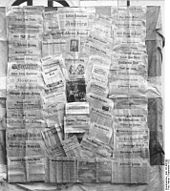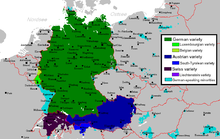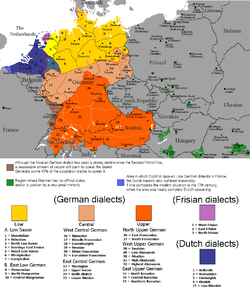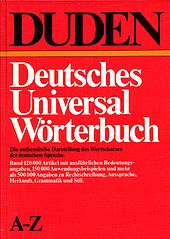
German language
Background to the schools Wikipedia
SOS Children offer a complete download of this selection for schools for use on schools intranets. SOS Child sponsorship is cool!
| German | ||||
|---|---|---|---|---|
| Deutsch, Deutsche Sprache | ||||
| Pronunciation | [ˈdɔʏtʃ] | |||
| Native to | Primarily in German-speaking Europe, as a minority language and amongst the German diaspora worldwide | |||
| Native speakers | Standard German: 90–100 million (2005–2010) all German: 120 million (1990–2005) L2 speakers: 80 million (2006) |
|||
| Language family |
Indo-European
|
|||
| Early forms: |
Old High German
|
|||
| Writing system | Latin ( German alphabet) German Braille |
|||
| Official status | ||||
| Official language in |
|
|||
| Recognised minority language in |
|
|||
| Regulated by |
No official regulation |
|||
| Language codes | ||||
| ISO 639-1 | de | |||
| ISO 639-2 | ger (B) deu (T) |
|||
| ISO 639-3 | Variously: deu – New High German gmh – Middle High German goh – Old High German gct – Alemán Coloniero bar – Austro-Bavarian cim – Cimbrian geh – Hutterite German ksh – Kölsch nds – Low German sli – Lower Silesian ltz – Luxembourgish vmf – Main-Franconian mhn – Mócheno pfl – Palatinate German pdc – Pennsylvania German pdt – Plautdietsch swg – Swabian German gsw – Swiss German uln – Unserdeutsch sxu – Upper Saxon wae – Walser German wep – Westphalian |
|||
| Linguasphere | 52-AC (Continental West Germanic) > 52-ACB (Deutsch & Dutch) > 52-ACB-d ( Central German incl. 52-ACB–dl & -dm Standard/Generalised High German) + 52-ACB-e & -f ( Upper German & Swiss German) + 52-ACB-g ( Yiddish) + 52-ACB-h ( émigré German varieties incl. 52-ACB-hc Hutterite German & 52-ACB-he Pennsylvania German etc.) + 52-ACB-i ( Yenish); totalling 285 varieties: 52-ACB-daa to 52-ACB-i |
|||
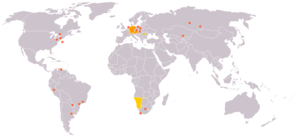 |
||||
|
||||
German (Deutsch [ˈdɔʏtʃ]) is a West Germanic language related to and classified alongside English and Dutch. With an estimated 90–100 million native speakers, German is one of the world's major languages and is the most widely-spoken first language in the European Union.
Most German vocabulary is derived from the Germanic branch of the Indo-European language family. A number of words are derived from Latin and Greek, and fewer from French and English.
German is written using the Latin alphabet. In addition to the 26 standard letters, German has three vowels with umlauts (Ä/ä, Ö/ö, and Ü/ü) and the letter ß.
History
Origins

The history of the language begins with the High German consonant shift during the migration period, separating Old High German dialects from Old Saxon. The earliest evidence of Old High German is from scattered Elder Futhark inscriptions, especially in Alemannic, from the 6th century AD; the earliest glosses ( Abrogans) date to the 8th; and the oldest coherent texts (the Hildebrandslied, the Muspilli and the Merseburg Incantations) to the 9th century. Old Saxon at this time belongs to the North Sea Germanic cultural sphere, and Low Saxon was to fall under German rather than Anglo-Frisian influence during the Holy Roman Empire.
As Germany was divided into many different states, the only force working for a unification or standardization of German for several hundred years was the general wish of writers to be understood by as many readers as possible.
Modern German
In Germany
When Martin Luther translated the Bible (the New Testament in 1522 and the Old Testament, published in parts and completed in 1534), he based his translation mainly on the bureaucratic standard language used in Saxony (sächsische Kanzleisprache), also known as Meißner-Deutsch (German from the city of Meissen). This language was based on Eastern Upper and Eastern Central German dialects and preserved much of the grammatical system of Middle High German (unlike the spoken German dialects in Central and Upper Germany, which had already at that time begun to lose the genitive case and the preterite tense). Initially, copies of the Bible had a long list of glosses for each region, which translated words unknown in the region into the regional dialect. Roman Catholics rejected Luther's translation initially and tried to create their own Catholic standard (gemeines Deutsch) — which, however, differed from "Protestant German" only in some minor details. It took until the middle of the 18th century to create a widely accepted standard, thus ending the period of Early New High German.

Until about 1800, standard German was mainly a written language: in urban northern Germany, the local dialects of Low Saxon or Low German were spoken; Standard German, which was markedly different, was often learned as a foreign language with uncertain pronunciation. Prescriptive pronunciation guides considered northern German pronunciation as the standard. However, the actual pronunciation of Standard German varies from region to region.
In the Austrian empire
German was the language of commerce and government in the Habsburg Empire, which encompassed a large area of Central and Eastern Europe. Until the mid-19th century it was essentially the language of townspeople throughout most of the Empire. Its use indicated that the speaker was a merchant, an urbanite, irrespective of nationality. Some cities, such as Prague (German: Prag) and Budapest ( Buda, German: Ofen), were gradually Germanized in the years after their incorporation into the Habsburg domain. Others, such as Pozsony (German: Pressburg, now Bratislava), were originally settled during the Habsburg period and were primarily German at that time. A few cities remained mainly non-German. However most cities, such as Prague, Budapest, Bratislava, Zagreb (German: Agram), and Ljubljana (German: Laibach), were primarily German during this time, although surrounded by territory where other languages were spoken.
Switzerland
In Switzerland, a number of local dialects are spoken in the German-speaking cantons, but standard German is used as a written language.
Standardization
In 1901, the 2nd Orthographical Conference ended with a complete standardization of the German language in its written form while the Deutsche Bühnensprache (literally, German stage language) had established rules for German three years earlier.
Media and written works are now almost all produced in Standard German (often called Hochdeutsch ("high German")) which is understood in all areas where German is spoken.
The first dictionary of the Brothers Grimm, the 16 parts of which were issued between 1852 and 1860, remains the most comprehensive guide to the vocabulary of the German language. In 1860, grammatical and orthographic rules first appeared in the Duden Handbook. In 1901, this was declared the standard definition of the German language. Official revisions of some of these rules were not issued until 1998, when a controversial spelling reform was officially promulgated by governments of all German-speaking countries.
Geographic distribution
German-speaking communities can be found in the former German colony of Namibia, independent from South Africa since 1990, as well as in other destinations of German emigration such as the USA, Canada, Mexico, Dominican Republic, Brazil, Argentina, Paraguay, Uruguay, Chile, Peru, Venezuela (where the dialect Alemán Coloniero developed), South Africa and Australia. In Namibia, German Namibians retain German educational institutions.
According to Global Reach (2004), 6.9% of the Internet population is German. According to Netz-tipp (2002), 7.7% of webpages are written in German, making it second only to English in the European language group. They also report that 12% of Google's users use its German interface.
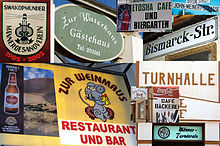
| Country | German speaking population (outside Europe) |
|---|---|
| 5,000,000 | |
| 3,000,000 | |
| 1,400,000 | |
| 450,000 – 620,000 | |
| 200,000 | |
| 110,000 | |
| 75,000 (German expatriate citizens alone) | |
| 40,000 | |
| 30,000 – 40,000 | |
| 37,500 | |
| 30,000 (German expatriate citizens alone) | |
| 10,000 | |
| 50,000 |
Europe
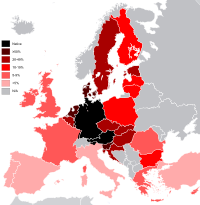
German is primarily spoken in Germany (where it is the first language for more than 95% of the population), Austria (89%), Switzerland (65%), the majority of Luxembourg, and Liechtenstein - the latter being the only state with German as the sole official and spoken language.
German is also one of the three official languages of Belgium, alongside Flemish and French. Speakers are primarily concentrated within the German-speaking Community region in eastern Belgium, and form about 1% of the country's population.
Other European German-speaking communities are found in Northern Italy (in South Tyrol and in some municipalities in other provinces), in the French regions of Alsace and Lorraine, and in some border villages of the former South Jutland County of Denmark.
German-speaking communities can also be found in parts of the Czech Republic, Slovakia, Hungary, Poland, Romania, Serbia, Russia and Kazakhstan. Forced expulsions after World War II and massive emigration to Germany in the 1980s and 1990s have depopulated most of these communities.
Africa
German is spoken by about 25-30,000 people as a mother tongue in the former German colony of Namibia. Though it no longer enjoys status as an official language, it is used in a wide variety of spheres, especially business and tourism, as well as churches (most notably the German-speaking Evangelical Lutheran Church in Namibia (GELK)), schools (e.g. the Deutsche Höhere Privatschule Windhoek), literatures (German-Namibian authors include Giselher W. Hoffmann), radio (German-language programming of the Namibian Broadcasting Corporation), and music (e.g. artist EES).
There is also some German medium education in Rwanda, Burundi, Togo, Cameroon and Tanzania.
There are a number of communities where German is spoken in South Africa, especially in and around Wartburg.
North America
In the United States, the states of North Dakota and South Dakota are the only states where German is the most common language spoken at home after English (the second most spoken language in other states is either Spanish or French). German geographical names can also be found throughout the Midwest region of the country, such as New Ulm and many other towns in Minnesota; Bismarck (North Dakota's state capital), Munich, Karlsruhe, and Strasburg in North Dakota; New Braunfels, Fredericksburg, and Muenster in Texas; and Kiel, Berlin and Germantown in Wisconsin.
Between 1843 and 1910, more than 5 million Germans emigrated overseas, mostly to the United States. German remained an important medium for churches, schools, newspapers, and even the administration of the United States Brewers' Association through the early 20th century, but was severely repressed during World War I. Over the course of the 20th century many of the descendants of 18th century and 19th century immigrants ceased speaking German at home, but small populations of speakers can still be found in Pennsylvania (Amish, Hutterites, Dunkards and some Mennonites historically spoke Hutterite German and a West Central German variety of German known as Pennsylvania German or Pennsylvania Dutch), Kansas (Mennonites and Volga Germans), North Dakota (Hutterite Germans, Mennonites, Russian Germans, Volga Germans, and Baltic Germans), South Dakota, Montana, Texas ( Texas German), Wisconsin, Indiana, Oregon, Oklahoma, and Ohio (72,570). A significant group of German Pietists in Iowa formed the Amana Colonies and continue to practice speaking their heritage language. Early twentieth century immigration was often to St. Louis, Chicago, New York, Milwaukee, Pittsburgh and Cincinnati.
The dialects of German which are or were primarily spoken in colonies or communities founded by German-speaking people resemble the dialects of the regions the founders came from. For example, Pennsylvania German resembles Palatinate German dialects, and Hutterite German resembles dialects of Carinthia. Texas German is a dialect spoken in the areas of Texas settled by the Adelsverein, such as New Braunfels and Fredericksburg. In the Amana Colonies in the state of Iowa, Amana German is spoken. Plautdietsch is a large minority language spoken in Northern Mexico by the Mennonite communities, and is spoken by more than 200,000 people in Mexico. Pennsylvania German is a West Central German dialect spoken by most of the Amish population of Pennsylvania, Ohio, and Indiana.
Hutterite German is an Upper German dialect of the Austro-Bavarian variety of the German language, which is spoken by Hutterite communities in Canada and the United States. Hutterite is spoken in the U.S. states of Washington, Montana, North Dakota, South Dakota, and Minnesota; and in the Canadian provinces of Alberta, Saskatchewan and Manitoba. Its speakers belong to some Schmiedleit, Lehrerleit, and Dariusleit Hutterite groups, but there are also speakers among the older generations of Prairieleit (the descendants of those Hutterites who chose not to settle in colonies). Hutterite children who grow up in the colonies learn to speak Hutterite German before learning English, the standard language of the surrounding areas, in school. Many of these children, though, continue with German Grammar School, in addition to public school, throughout a student's elementary education.
In Canada, there are 622,650 speakers of German according to the most recent census in 2006, while people of German ancestry ( German Canadians) are found throughout the country. German-speaking communities are particularly found in British Columbia (118,035) and Ontario (230,330). There is a large and vibrant community in the city of Kitchener, Ontario, which was at one point named Berlin. German immigrants were instrumental in the country's three largest urban areas: Montreal, Toronto, and Vancouver; while post-Second World War immigrants managed to preserve a fluency in the German language in their respective neighborhoods and sections. In the first half of the 20ᵗʰ century, over a million German-Canadians made the language Canada's third most spoken after French and English.
In Mexico there are also large populations of German ancestry, mainly in the cities of: Mexico City, Puebla, Mazatlán, Tapachula, Ecatepec de Morelos, and larger populations scattered in the states of Chihuahua, Durango, and Zacatecas.
South America
In Brazil, the largest concentrations of German speakers are in the states of Rio Grande do Sul (where Riograndenser Hunsrückisch developed), Santa Catarina, Paraná, São Paulo and Espírito Santo. There are also important concentrations of German-speaking descendants in Argentina, Paraguay, Venezuela, Bolivia and Chile. In the 20th century, over 100,000 German political refugees and invited entrepreneurs settled in Latin America, in countries such as Costa Rica, Panama, Venezuela, and the Dominican Republic, to establish German-speaking enclaves, and reportedly there is a small German immigration to Puerto Rico. Nearly all inhabitants of the city of Pomerode, a municipality where this language is co-oficial in the state of Santa Catarina in Brazil, can speak German.
In most locations where German immigrants settled, the vast majority of their descendents no longer speak German, as they have been largely assimilated into the host language and culture of the specific location of settlement; generally English in North America, and Spanish or Portuguese in Latin America. However, the Brazilian state Espírito Santo has Pomeranian and German as linguistic heritages officially approved statewide, while Rio Grande do Sul has Riograndenser Hunsrückisch German as linguistic heritage officially approved statewide. Moreover, some cities in Brazil have the German or Pomeranian as co-oficial languages. They are:
Municipalities that have co-official Pomeranian (or Pommersch) language:

Espírito Santo:
- Domingos Martins
- Laranja da Terra
- Pancas
- Santa Maria de Jetibá
- Vila Pavão
Minas Gerais:
- Itueta (only in the district of Vila Nietzel)
Santa Catarina:
- Pomerode
Rio Grande do Sul:
- Canguçu (under approval)
Rondônia:
- Espigão d'Oeste (under approval)
Municipalities that have co-official language Riograndenser Hunsrückisch language:
Santa Catarina:
- Antônio Carlos
- Treze Tílias (language teaching is compulsory in schools, standing on stage in public official of the municipality)
Rio Grande do Sul:
- Santa Maria do Herval (under approval)
Oceania
In Australia, the state of South Australia experienced a pronounced wave of immigration in the 1840s from Prussia (particularly the Silesia region). With the prolonged isolation from other German speakers and contact with Australian English, a unique dialect known as Barossa German has developed and is spoken predominantly in the Barossa Valley near Adelaide. Usage of German sharply declined with the advent of World War I, due to the prevailing anti-German sentiment in the population and related government action. It continued to be used as a first language into the twentieth century but now its use is limited to a few older speakers.
German migration to New Zealand in the 19th century was less pronounced than migration from Britain, Ireland, and perhaps even Scandinavia. Despite this there were significant pockets of German speaking communities which lasted until the first decades of the 20th century. German-speakers settled principally in Puhoi, Nelson, and Gore. At the last census (2006), 37,500 people in New Zealand spoke German, making it the third most spoken European language after English and French and overall the ninth most spoken language.
There is also an important German creole being studied and recovered, named Unserdeutsch, spoken in the former German colony of Papua New Guinea, across Micronesia and in northern Australia (i.e. coastal parts of Queensland and Western Australia), by a few elderly people. The risk of its extinction is serious and efforts to revive interest in the language are being implemented by scholars.
Standard German
Standard German originated not as a traditional dialect of a specific region, but as a written language. However, there are places where the traditional regional dialects have been replaced by standard German; this is the case in large stretches of Northern Germany, but also in major cities in other parts of the country.
Standard German differs regionally, between German-speaking countries, in vocabulary and some instances of pronunciation, and even grammar and orthography. This variation must not be confused with the variation of local dialects. Even though the regional varieties of standard German are only to a certain degree influenced by the local dialects, they are very distinct. German is thus considered a pluricentric language.
In most regions, the speakers use a continuum from more dialectal varieties to more standard varieties according to circumstances.
In the German-speaking parts of Switzerland, mixtures of dialect and standard are very seldom used, and the use of standard German is largely restricted to the written language. This situation has been called a medial diglossia. Swiss Standard German is used in the Swiss, Austrian Standard German officially in the Austrian education system.
Official status
Standard German is the only official language in Liechtenstein; it shares official status in Germany (with Danish, Frisian, Romany and Sorbian as minority languages), in Austria (with Slovene, Croatian, and Hungarian as minority languages), Switzerland (with French, Italian and Romansh), Belgium (with Dutch ( Flemish) and French) and Luxembourg (with French and Luxembourgish). It is an official regional language in Italy ( South Tyrol), as well as in the cities of Sopron (Hungary), Krahule (Slovakia) and several cities in Romania. It is the official language of command (together with Italian) of the Vatican Swiss Guard.
German has an officially recognized status as a regional or auxiliary language in Denmark ( Southern Jutland region), Italy (Gressoney valley), Namibia, Poland ( Opole region), and Russia (Asowo and Halbstadt).
German is one of the 23 official languages of the European Union and one of the three working languages. It is the language with the largest number of native speakers in the European Union, and is the second-most spoken language in Europe, just behind English and ahead of French.
German as a foreign language
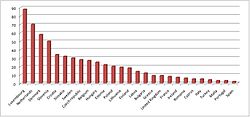
German is the third most taught foreign language in the English-speaking world, after French and Spanish.
German is the main language of about 90 – 98 million people in Europe (as of 2004), or 13.3% of all Europeans; it is the second most spoken native language in Europe after Russian, above French (66.5 million speakers in 2004) and English (64.2 million speakers in 2004). It is therefore the most spoken first language in the EU. It is the second most known foreign language in the EU. It is one of the official languages of the European Union, and one of the three working languages of the European Commission, along with English and French. Among citizens of the EU-15 countries, 32% say they can converse in German (either as a mother tongue or as a second or foreign language). This is assisted by the widespread availability of German TV by cable or satellite.
Dialects
German is a member of the western branch of the Germanic family of languages, which in turn is part of the Indo-European language family. The German dialect continuum is traditionally divided most broadly into High German and Low German, also called Low Saxon. Yet, historically, High German dialects and Low Saxon/Low German dialects do not belong to the same language. Nevertheless, in today's Germany, Low Saxon/Low German is often perceived as a dialectal variation of Standard German on a functional level, even by many native speakers. The same phenomenon is found in the eastern Netherlands, as the traditional dialects are not always identified with their Low Saxon/Low German origins, but with Dutch.
The variation among the German dialects is considerable, with often only neighbouring dialects being mutually intelligible. Some dialects are not intelligible to people who only know standard German. However, all German dialects belong to the dialect continuum of High German and Low Saxon languages.
Low German
Middle Low German was the lingua franca of the Hanseatic League. It was the predominant language in Northern Germany. This changed in the 16th century: in 1534 the Luther Bible was published. This translation is considered to be an important step towards the evolution of the Early New High German. It aimed to be understandable to a broad audience and was based mainly on Central and Upper German varieties. The Early New High German language gained more prestige than Low German and became the language of science and literature. Around the same time, the Hanseatic league, based around northern ports, lost its importance as new trade routes to Asia and the Americas were established, while the most powerful German states of that period were located in Middle and Southern Germany.
The 18th and 19th centuries were marked by mass education in Standard German in schools. Gradually Low German came to be politically viewed as a mere dialect spoken by the uneducated. Today Low Saxon can be divided in two groups: Low Saxon varieties with a reasonable standard German influx and varieties of Standard German with a Low Saxon influence known as Missingsch. Sometimes, Low Saxon and Low Franconian varieties are grouped together because both are unaffected by the High German consonant shift. However, the proportion of the population who can understand and speak it has decreased continuously since World War II.
High German
High German is divided into Central German, High Franconian (a transitional dialect), and Upper German. Central German dialects include Ripuarian, Moselle Franconian, Rhine Franconian, Central Hessian, East Hessian, North Hessian, Thuringian, Silesian German, Lorraine Franconian, Mittelalemannisch, North Upper Saxon, High Prussian, Lausitzisch-Neumärkisch and Upper Saxon. It is spoken in the southeastern Netherlands, eastern Belgium, Luxembourg, parts of France, and parts of Germany roughly between the River Main and the southern edge of the Lowlands. Modern Standard German is mostly based on Central German, although the common (but not linguistically correct) German term for modern Standard German is Hochdeutsch, that is, High German.
The Moselle Franconian varieties spoken in Luxembourg have been officially standardised and institutionalised and are usually considered a separate language known as Luxembourgish.
The two High Franconian dialects are East Franconian and South Franconian.
Upper German dialects include Northern Austro-Bavarian, Central Austro-Bavarian, Southern Austro-Bavarian, Swabian, East Franconian, High Alemannic German, Highest Alemannic German, Alsatian and Low Alemannic German. They are spoken in parts of the Alsace, southern Germany, Liechtenstein, Austria, and the German-speaking parts of Switzerland and Italy.
Vilamovian is a High German dialect of Poland, and Sathmarisch and Siebenbürgisch are High German dialects of Romania. The High German varieties spoken by Ashkenazi Jews (mostly in the former Soviet Union) have several unique features, and are usually considered as a separate language, Yiddish. It is the only Germanic language that does not use the Latin script as the basis of its standard alphabet.
Varieties of standard German
In German linguistics, German dialects are distinguished from varieties of standard German.
- The German dialects are the traditional local varieties. They are traditionally traced back to the different German tribes. Many of them are hardly understandable to someone who knows only standard German, since they often differ from standard German in lexicon, phonology and syntax. If a narrow definition of language based on mutual intelligibility is used, many German dialects are considered to be separate languages (for instance in the Ethnologue). However, such a point of view is unusual in German linguistics.
- The varieties of standard German refer to the different local varieties of the pluricentric standard German. They only differ slightly in lexicon and phonology. In certain regions, they have replaced the traditional German dialects, especially in Northern Germany.
Grammar
German is an inflected language with three grammatical genders; as such, there can be a large number of words derived from the same root.
Noun inflection
German nouns inflect into:
- four cases: nominative, genitive, dative, and accusative.
- three genders: masculine, feminine, or neuter. Word endings sometimes reveal grammatical gender: for instance, nouns ending in ...ung (ing), ...schaft (-ship), ...keit or ...heit (-hood) are feminine, while nouns ending in ...chen or ...lein ( diminutive forms) are neuter and nouns ending in ...ismus ( -ism) are masculine. Others are controversial, sometimes depending on the region in which it is spoken. Additionally, ambiguous endings exist, such as ...er ( -er), e.g. Feier (feminine), celebration, party, Arbeiter (masculine), labourer, and Gewitter (neuter), thunderstorm.
- two numbers: singular and plural
This degree of inflection is considerably less than in Old High German and in other old Indo-European languages such as Latin, Ancient Greek, or Sanskrit, and somewhat less than, for instance, in modern Icelandic and Russian. The three genders have collapsed in the plural, which now behaves, grammatically, somewhat as a fourth gender. With four cases and three genders plus plural there are 16 distinct possible combinations of case and gender/number, but presently there are only six forms of the definite article used for the 16 possibilities. Inflection for case on the noun itself is required in the singular for strong masculine and neuter nouns in the genitive and sometimes in the dative. Both of these cases are losing ground to substitutes in informal speech. The dative ending is considered somewhat old-fashioned in many contexts and often dropped, but it is still used in proverbs and the like, in formal speech and in written language. Weak masculine nouns share a common case ending for genitive, dative and accusative in the singular. Feminine nouns are not declined in the singular. The plural does have an inflection for the dative. In total, seven inflectional endings (not counting plural markers) exist in German: -s, -es, -n, -ns, -en, -ens, -e.
In German orthography, nouns and most words with the syntactical function of nouns are capitalised, which is supposed to make it easier for readers to find out what function a word has within the sentence (Am Freitag ging ich einkaufen.—"On Friday I went shopping."; Eines Tages kreuzte er endlich auf.—"One day he finally showed up.") This convention is almost unique to German today (shared perhaps only by the closely related Luxemburgish language and several insular dialects of the North Frisian language), although it was historically common in other languages such as Danish and English.
Like most Germanic languages, German forms noun compounds where the first noun modifies the category given by the second, for example: Hundehütte ("dog hut"; specifically: "dog kennel"). Unlike English, where newer compounds or combinations of longer nouns are often written in "open" with separating spaces, German (like some other Germanic languages) nearly always uses the "closed" form without spaces, for example: Baumhaus ("tree house"). German allows arbitrarily long compounds, as English does to some extent. (See also English compounds.) In German these are quite common. The longest German word verified to be actually in (albeit very limited) use is Rindfleischetikettierungsüberwachungsaufgabenübertragungsgesetz, which, literally translated, is "beef labelling supervision duty assignment law" [from Rind (cattle), Fleisch (meat), Etikettierung(s) (labelling), Überwachung(s) (supervision), Aufgaben (duties), Übertragung(s) (assignment), Gesetz (law)]. However, examples like this are perceived as excessively bureaucratic, stylistically awkward, and even satiric by native speakers.
Verb inflection
Inflection of standard German verbs includes:
- two main conjugation classes: weak and strong (as in English). Additionally, there is a third class, known as mixed verbs, whose conjugation combines features of both the strong and weak patterns.
- three persons: 1st, 2nd, 3rd.
- two numbers: singular and plural
- three moods: indicative, imperative, subjunctive (in addition to infinitive)
- two voices: active and passive; the passive voice uses auxiliary verbs and is dividable into static and dynamic.
- two tenses without auxiliary verbs ( present, preterite) and four tenses constructed with auxiliary verbs ( perfect, pluperfect, future and future perfect)
- the distinction between grammatical aspects is rendered by combined use of subjunctive and/or preterite marking: thus the plain indicative voice uses neither of those two markers; the subjunctive by itself conveys second-hand information; subjunctive plus preterite marks the conditional state; and the preterite alone shows either plain indicative (in the past), or functions as a (literal) alternative for either second-hand-information or the conditional state of the verb, when necessary for clarity.
- the distinction between perfect and progressive aspect is and has at every stage of development been a productive category of the older language and in nearly all documented dialects, but, strangely enough, is nowadays rigorously excluded from written usage in its present normalised form.
- disambiguation of completed vs. uncompleted forms is widely observed and regularly generated by common prefixes (blicken - to look, erblicken - to see [unrelated form: sehen - to see]).
- Verb prefixes
The meaning of basic verbs can be expanded, and sometimes radically changed, through the use of a number of prefixes. Some prefixes have a specific meaning; the prefix zer- refers to destruction, as in zerreißen (to tear apart), zerbrechen (to break apart), zerschneiden (to cut apart). Other prefixes have only the vaguest meaning in themselves; ver- is found in a number of verbs with a large variety of meanings, as in versuchen (to try), vernehmen (to interrogate), verteilen (to distribute), verstehen (to understand).
Other examples include haften (to stick), verhaften (to detain); kaufen (to buy), verkaufen (to sell); hören (to hear), aufhören (to cease); fahren (to drive), erfahren (to experience).
Many German verbs have a separable prefix, often with an adverbial function. In finite verb forms this is split off and moved to the end of the clause, and is hence considered by some to be a "resultative particle". For example, mitgehen meaning "to go along" would be split, giving Gehen Sie mit? (Literal: "Go you with?" ; Formal: "Are you going along?").
Indeed, several parenthetical clauses may occur between the prefix of a finite verb and its complement: e.g.
- Er kam am Freitagabend nach einem harten Arbeitstag und dem üblichen Ärger, der ihn schon seit Jahren immer wieder an seinem Arbeitsplatz plagt, mit fraglicher Freude auf ein Mahl, das seine Frau ihm, wie er hoffte, bereits aufgetischt hatte, endlich zu Hause an .
A selectively literal translation of this example to illustrate the point might look like this:
- He -rived on Friday evening, after a hard day at work and the usual annoyances that had time and again been troubling him for years now at his workplace, with questionable joy, to a meal which, as he hoped, his wife had already put on the table, finally at home ar-.
Word order
Word order is generally less rigid than in Modern English. There are two common word orders: one is for main clauses and another for subordinate clauses. In normal affirmative sentences the inflected verb always has position 2. In polar questions, exclamations, and wishes it always has position 1. In subordinate clauses the verb is supposed to occur at the very end, but in speech this rule is often disregarded.
German requires that a verbal element (main verb or auxiliary verb) appear second in the sentence. The verb is preceded by the topic of the sentence. The element in focus appears at the end of the sentence. For a sentence without an auxiliary this gives, amongst other options:
- Der alte Mann gab mir gestern das Buch. (The old man gave me yesterday the book; normal order)
- Das Buch gab mir gestern der alte Mann. (The book gave [to] me yesterday the old man)
- Das Buch gab der alte Mann mir gestern. (The book gave the old man [to] me yesterday)
- Gestern gab mir der alte Mann das Buch. (Yesterday gave [to] me the old man the book, normal order)
- Mir gab der alte Mann das Buch gestern. ([To] me gave the old man the book yesterday (entailing: as for you, it was another date))
The position of a noun in a German sentence has no bearing on its being a subject, an object, or another argument. In a declarative sentence in English if the subject does not occur before the predicate the sentence could well be misunderstood. This is not the case in German.
- Auxiliary verbs
When an auxiliary verb is present, the auxiliary appears in second position, and the main verb appears at the end. This occurs notably in the creation of the perfect. Many word orders are still possible, e.g.:
- Der alte Mann hat mir heute das Buch gegeben. (The old man has given me the book today.)
- Das Buch hat der alte Mann mir heute gegeben. (The book has the old man given me today.)
- Heute hat der alte Mann mir das Buch gegeben. (Today the old man has given me the book.)
- Modal verbs
Sentences using modal verbs place the infinitive at the end. For example, the sentence in Modern English "Should he go home?" would be rearranged in German to say "Should he (to) home go?" (Soll er nach Hause gehen?). Thus in sentences with several subordinate or relative clauses the infinitives are clustered at the end. Compare the similar clustering of prepositions in the following English sentence: "What did you bring that book which I don't like to be read to out of up for?"
- Multiple infinitives
German subordinate clauses have all verbs clustered at the end. Given that auxiliaries encode future, passive, modality, and the perfect, this can lead to very long chains of verbs at the end of the sentence. In these constructions, the past participle in ge- is often replaced by the infinitive.
Man nimmt an, dass der Deserteur wohl erschossenV wordenpsv seinperf solltemod
One suspects that the deserter probably shot become be should
("It is suspected that the deserter probably should have been shot")
The order at the end of such strings is subject to variation, though the latter version is unusual.
Er wusste nicht, dass der Agent einen Nachschlüssel hatte machen lassen
He knew not that the agent a picklock had make let
Er wusste nicht, dass der Agent einen Nachschlüssel machen lassen hatte
He knew not that the agent a picklock make let had
("He did not know that the agent had had a picklock made")
Vocabulary
Most German vocabulary is derived from the Germanic branch of the Indo-European language family. However, there is a significant amount of loanwords from other languages, in particular from Latin, Greek, Italian, French and most recently English.
Latin words were already imported into the predecessor of the German language during the Roman Empire and underwent all the characteristic phonetic changes in German. Their origin is thus no longer recognizable for most speakers (e.g. Pforte, Tafel, Mauer from Latin porta, tabula, murus). Borrowing from Latin continued after the fall of the Roman Empire during Christianization, mediated by the church and monasteries. Another important influx of Latin words can be observed during Renaissance humanism. In a scholarly context, the borrowings from Latin have continued until today, in the last decades often indirectly through borrowings from English. During the 15th to 17th centuries, the influence of Italian was great, leading to many Italian loanwords in the fields of architecture, finance, and music. The influence of the French language in the 17th to 19th centuries resulted in an even greater import of French words. The English influence was already present in the 19th century, but did not become dominant until the second half of the 20th century.
At the same time, the effectiveness of the German language in forming equivalents for foreign words from its inherited Germanic stem repertory is great. Thus, Notker Labeo was able to translate Aristotelian treatises in pure (Old High) German in the decades after the year 1000. The tradition of loan translation was revitalized in the 18th century, with linguists like Joachim Heinrich Campe who introduced hundreds of words that are still used in modern German. Even today, there are movements that try to promote the Ersatz (substitution) of foreign words deemed unnecessary with German alternatives. It is claimed that this would also help in spreading modern or scientific notions among the less educated, and thus democratise public life, too.
As in English, there are many pairs of synonyms due to the enrichment of the Germanic vocabulary with loanwords from Latin and Latinized Greek. These words often have different connotations from their Germanic counterparts and are usually perceived as more scholarly.
- Jahrtausend — Millennium "millennium"
- Wortschatz — Vokabular "vocabulary"
- Wahrnehmung — Perzeption "perception"
- geschichtlich — historisch "historical"
The size of the vocabulary of German is difficult to estimate. The Deutsches Wörterbuch (The German Dictionary) initiated by Jacob and Wilhelm Grimm already contained over 330,000 headwords in its first edition. The modern German scientific vocabulary is estimated at nine million words and word groups (based on the analysis of 35 million sentences of a corpus in Leipzig, which as of July 2003 included 500 million words in total).
Orthography
German is written in the Latin alphabet. In addition to the 26 standard letters, German has three vowels with Umlaut, namely ä, ö and ü, as well as the Eszett or scharfes s (sharp s), ß. In Switzerland "ss" is used instead of "ß". Additionally, when written in capitals, "ß" is replaced with "SS" in Germany, while in Austria it is traditionally replaced with "SZ" (like in Hungarian); there are some exceptions to these rules (see below).
Written texts in German are easily recognisable as such by distinguishing features such as umlauts and certain orthographical features—German is the only major language that capitalizes all nouns—and the frequent occurrence of long compounds. The longest German word that has been published is " Donaudampfschiffahrtselektrizitätenhauptbetriebswerkbauunterbeamtengesellschaft" made of 79 characters. Since legibility and convenience set certain boundaries, compounds consisting of more than three or four nouns are almost exclusively found in humorous contexts.
Present
Before the German spelling reform of 1996, ß replaced ss after long vowels and diphthongs and before consonants, word-, or partial-word-endings. In reformed spelling, ß replaces ss only after long vowels and diphthongs. Since there is no capital ß, it is always written as "SS" when capitalization is required. For example, Maßband (tape measure) is capitalized MASSBAND. An exception is the use of ß in legal documents and forms when capitalizing names. To avoid confusion with similar names, a "ß" is to be used instead of "SS". (So: "KREßLEIN" instead of "KRESSLEIN".) A capital ß has been proposed and included in Unicode ("ẞ"; Unicode character U+1E9E), but it is not yet recognized as standard German. In Switzerland, ß is not used at all.
Umlaut vowels (ä, ö, ü) are commonly transcribed with ae, oe, and ue if the umlauts are not available on the keyboard or other medium used. In the same manner ß can be transcribed as ss. Some operating systems use key sequences to extend the set of possible characters to include, amongst other things, umlauts; in Microsoft Windows this is done using Alt codes. German readers understand those transcriptions (although they look unusual), but they are avoided if the regular umlauts are available because they are a makeshift, not proper spelling. (In Westphalia and Schleswig-Holstein, city and family names exist where the extra e has a vowel lengthening effect, e.g. Raesfeld [ˈraːsfɛlt], Coesfeld [ˈkoːsfɛlt] and Itzehoe [ɪtsəˈhoː], but this use of the letter e after a/o/u does not occur in the present-day spelling of words other than proper nouns.)
 |
German alphabet
(Listen to a German speaker recite the alphabet in German)
|
| Problems listening to this file? See media help. | |
There is no general agreement on where letters with umlauts occur in the sorting sequence. Telephone directories treat them by replacing them with the base vowel followed by an e. Some dictionaries sort each umlauted vowel as a separate letter after the base vowel, but more commonly words with umlauts are ordered immediately after the same word without umlauts. As an example in a telephone book Ärzte occurs after Adressenverlage but before Anlagenbauer (because Ä is replaced by Ae). In a dictionary Ärzte comes after Arzt, but in some dictionaries Ärzte and all other words starting with Ä may occur after all words starting with A. In some older dictionaries or indexes, initial Sch and St are treated as separate letters and are listed as separate entries after S, but they are usually treated as S+C+H and S+T.
Written German also typically uses an alternative opening inverted comma ( quotation mark) as in „Guten Morgen!”.
Past
Until the early 20th century, German was mostly printed in blackletter typefaces (mostly in Fraktur, but also in Schwabacher) and written in corresponding handwriting (for example Kurrent and Sütterlin). These variants of the Latin alphabet are very different from the serif or sans serif Antiqua typefaces used today, and particularly the handwritten forms are difficult for the untrained to read. The printed forms however were claimed by some to be actually more readable when used for printing Germanic languages. (Often, foreign names in a text were printed in a "normal" typeface even though the rest of the text was in Fraktur.) The Nazis initially promoted Fraktur and Schwabacher since they were considered Aryan, although they abolished them in 1941, claiming that these letters were Jewish. The Fraktur script remains present in everyday life in pub signs, beer brands and other forms of advertisement, where it is used to convey a certain rusticality and oldness.
A proper use of the long s, (langes s), ſ, is essential for writing German text in Fraktur typefaces. Many Antiqua typefaces include the long s also. A specific set of rules applies for the use of long s in German text, but nowadays it is rarely used in Antiqua typesetting. Any lower case "s" at the beginning of a syllable would be a long s, as opposed to a terminal s or short s (the more common variation of the letter s), which marks the end of a syllable; for example, in differentiating between the words Wachſtube (guard-house) and Wachstube (tube of floor polish). One can easily decide which "s" to use by appropriate hyphenation, ("Wach-ſtube" vs. "Wachs-tube"). The long s only appears in lower case.
Reform of 1996
The spelling reform of 1996 led to public controversy and considerable dispute. The states (Bundesländer) of North Rhine-Westphalia and Bavaria would not accept it. The dispute landed at one point in the highest court, which made a short issue of it, claiming that the states had to decide for themselves and that only in schools could the reform be made the official rule—everybody else could continue writing as they had learned it. After 10 years, without any intervention by the federal parliament, a major revision was installed in 2006, just in time for the coming school year. In 2007, some traditional spellings were finally invalidated, while in 2008, on the other hand, many of the old comma rules were again put in force.
The most noticeable change was probably in the use of the letter ß, called scharfes s (Sharp S) or ess-zett (pronounced ess-tsett). Traditionally, this letter was used in three situations: 1) after a long vowel or vowel combination, 2) before a t, and 3) at the end of a syllable, thus Füße, paßt, and daß. Currently only the first rule is in effect, thus Füße, passt, and dass. The word Fuß 'foot' has the letter ß because it contains a long vowel, even though that letter occurs at the end of a syllable. The logic of this change is that an 'ß' is a single letter whereas 'ss' obviously are two letters, so the same distinction applies as for instance between the words 'den' and 'denn'.
Phonology
Vowels
In German, vowels (excluding diphthongs; see below) are either short or long, as follows:
| A | Ä | E | I | O | Ö | U | Ü | |
|---|---|---|---|---|---|---|---|---|
| short | /a/ | /ɛ/ | /ɛ/, /ə/ | /ɪ/ | /ɔ/ | /œ/ | /ʊ/ | /ʏ/ |
| long | /aː/ | /ɛː/ | /eː/ | /iː/ | /oː/ | /øː/ | /uː/ | /yː/ |
Short /ɛ/ is realized as [ɛ] in stressed syllables (including secondary stress), but as [ə] in unstressed syllables. Note that stressed short /ɛ/ can be spelled either with e or with ä (hätte 'would have' and Kette 'chain', for instance, rhyme). In general, the short vowels are open and the long vowels are closed. The one exception is the open /ɛː/ sound of long Ä; in some varieties of standard German, /ɛː/ and /eː/ have merged into [eː], removing this anomaly. In that case, pairs like Bären/Beeren 'bears/berries' or Ähre/Ehre 'spike (of wheat)/honour' become homophonous.
In many varieties of standard German, an unstressed /ɛr/ is not pronounced [ər], but vocalised to [ɐ].
Whether any particular vowel letter represents the long or short phoneme is not completely predictable, although the following regularities exist:
- If a vowel (other than i) is at the end of a syllable or followed by a single consonant, it is usually pronounced long (e.g. Hof [hoːf]).
- If a vowel (other than i) is followed by h or if an i is followed by an e, it is long.
- If the vowel is followed by a double consonant (e.g. ff, ss or tt), ck, tz or a consonant cluster (e.g. st or nd), it is nearly always short (e.g. hoffen [ˈhɔfən]). Double consonants are used only for this function of marking preceding vowels as short; the consonant itself is never pronounced lengthened or doubled, in other words this is not a feeding order of gemination and then vowel shortening.
Both of these rules have exceptions (e.g. hat [hat] 'has' is short despite the first rule; Mond [moːnt], 'moon' is long despite the second rule). For an i that is neither in the combination ie (making it long) nor followed by a double consonant or cluster (making it short), there is no general rule. In some cases, there are regional differences: In central Germany (Hessen), the o in the proper name "Hoffmann" is pronounced long while most other Germans would pronounce it short; the same applies to the e in the geographical name "Mecklenburg" for people in that region. The word Städte 'cities', is pronounced with a short vowel [ˈʃtɛtə] by some (Jan Hofer, ARD Television) and with a long vowel [ˈʃtɛːtə] by others (Marietta Slomka, ZDF Television). Finally, a vowel followed by ch can be short (Fach [fax] 'compartment', Küche [ˈkʏçə] 'kitchen') or long (Suche [ˈzuːxə] 'search', Bücher [ˈbyːçɐ] 'books') almost at random. Thus, Lache is homographous between [laːxə] Lache 'puddle' and [laxə] Lache 'manner of laughing' (colloquial) or lache! 'laugh!' (imperative).
German vowels can form the following digraphs (in writing) and diphthongs (in pronunciation); note that the pronunciation of some of them (ei, äu, eu) is very different from what one would expect when considering the component letters:
| spelling | ai, ei, ay, ey | au | äu, eu |
|---|---|---|---|
| pronunciation | /aɪ̯/ | /aʊ̯/ | /ɔʏ̯/ |
Additionally, the digraph ie generally represents the phoneme /iː/, which is not a diphthong. In many varieties, an /r/ at the end of a syllable is vocalised. However, a sequence of a vowel followed by such a vocalised /r/ is not considered a diphthong: Bär [bɛːɐ̯] 'bear', er [eːɐ̯] 'he', wir [viːɐ̯] 'we', Tor [toːɐ̯] 'gate', kurz [kʊɐ̯ts] 'short', Wörter [vœɐ̯tɐ] 'words'.
In most varieties of standard German, syllables that begin with a vowel are preceded by a glottal stop [ʔ].
Consonants
With approximately 25 phonemes, the German consonant system exhibits an average number of consonants in comparison with other languages. One of the more noteworthy ones is the unusual affricate /p͡f/. The consonant inventory of the standard language is shown below.
| Bilabial | Labiodental | Alveolar | Postalveolar | Palatal | Velar | Uvular | Glottal | |
|---|---|---|---|---|---|---|---|---|
| Plosive | p3 b4 | t3 d4 | k3 ɡ4 | |||||
| Affricate | pf | ts | tʃ (dʒ)5 | |||||
| Fricative | f v | s z | ʃ (ʒ)5 | x1 | h | |||
| Nasal | m | n | ŋ | |||||
| Approximant | l | j | ||||||
| Rhotic | r2 |
- 1/x/ has two allophones, [x] and [ç], after back and front vowels, respectively.
- 2/r/ has three allophones in free variation: [r], [ʁ] and [ʀ]. In the syllable coda, the allophone [ɐ] is found in many varieties.
- 3 The voiceless stops /p/, /t/, /k/ are aspirated except when preceded by a sibilant, exactly as in English.
- 4 The voiced stops /b/, /d/, /ɡ/ are devoiced to /p/, /t/, /k/, respectively, in word-final position.
- 5/d͡ʒ/ and /ʒ/ occur only in words of foreign (usually English or French) origin.
- Where a stressed syllable has an initial vowel, it is preceded by [ʔ]. As its presence is predictable from context, [ʔ] is not considered a phoneme.
- Consonant spellings
- c standing by itself is not a German letter. In borrowed words, it is usually pronounced [t͡s] (before ä, äu, e, i, ö, ü, y) or [k] (before a, o, u, and consonants). The combination ck is, as in English, used to indicate that the preceding vowel is short.
- ch occurs most often and is pronounced either [ç] (after ä, ai, äu, e, ei, eu, i, ö, ü and consonants; in the diminutive suffix -chen; and at the beginning of a word), [x] (after a, au, o, u), or [k] at the beginning of a word before a, o, u and consonants. Ch never occurs at the beginning of an originally German word. In borrowed words with initial Ch before bright vowels (Chemie "chemistry" etc.), [ç] is considered standard, but is itself practically absent from language in use. Upper Germans and Franconians (in the geographical sense) replace them with [k], as German as a whole does before darker vowels and consonants such as in Charakter, Christentum. Middle Germans (except Franconians) will borrow a [ʃ] from the French model. Both agree in considering each other's variant, and Upper Germans also the standard in [ç], as particularly awkward and unusual.
- dsch is pronounced [d͡ʒ] (like j in Jungle) but appears in a few loanwords only.
- f is pronounced [f] as in "father".
- h is pronounced [h] as in "home" at the beginning of a syllable. After a vowel it is silent and only lengthens the vowel (e.g. Reh = roe deer).
- j is pronounced [j] in Germanic words (Jahr [jaːɐ]). In recent loanwords, it follows more or less the respective languages' pronunciations.
- l is always pronounced [l], never *[ɫ] (the English " dark L").
- q only exists in combination with u and appears in both Germanic and Latin words (quer; Qualität). The digraph qu is pronounced [kv].
- r is usually pronounced in a guttural fashion (a voiced uvular fricative [ʁ] or uvular trill [ʀ]) in front of a vowel or consonant (Rasen [ˈʁaːzən]; Burg [buʁk]). In spoken German, however, it is commonly vocalised after a vowel (er being pronounced rather like [ˈɛɐ]—Burg [buɐk]). In some varieties, the r is pronounced as a "tongue-tip" r (the alveolar trill [r]).
- s in Germany, is pronounced [z] (as in "zebra") if it forms the syllable onset (e.g. Sohn [zoːn]), otherwise [s] (e.g. Bus [bʊs]). In Austria and Switzerland, it is always pronounced [s]. A ss [s] indicates that the preceding vowel is short. st and sp at the beginning of words of German origin are pronounced [ʃt] and [ʃp], respectively.
- ß (a letter unique to German called scharfes S or Eszett) was a ligature of a double s and of an sz and is always pronounced [s]. Originating in Blackletter typeface, it traditionally replaced ss at the end of a syllable (e.g. ich muss → ich muß; ich müsste → ich müßte); within a word it contrasts with ss [s] in indicating that the preceding vowel is long (compare in Maßen [in ˈmaːsən] "with moderation" and in Massen [in ˈmasən] "in loads"). The use of ß has recently been limited by the latest German spelling reform and is no longer used for ss after a short vowel (e.g. "ich muß" and "ich müßte" were always pronounced with a short U/Ü); Switzerland and Liechtenstein already abolished it in 1934.
- sch is pronounced [ʃ] (like "sh" in "shine").
- tion in Latin loanwords is pronounced [tsion].
- v is pronounced [f] in words of Germanic origin, such as Vater [ˈfaːtɐ], Vogel "bird", von "from, of", vor "before, in front of", voll "full" and the prefix ver-. It is also used in loanwords, where it is supposed to be pronounced [v]. This pronunciation is retained for example in Vase, Vikar, Viktor, Viper, Ventil, vulgär, and English loanwords; however, pronunciation tends to [f] the further you travel south. Some words, such as Ventil and the name Valentin (not, for example, Vase) have reached a plain f in Bavaria and Swabia.
- w is pronounced [v] as in "vacation" (e.g. was [vas]).
- y only in loanwords, generally as a vowel.
- z is always pronounced [t͡s] (e.g. zog [t͡soːk]). A tz indicates that the preceding vowel is short.
Consonant shifts
German does not have any dental fricatives (as English th). The th sounds, which the English language still has, disappeared on the continent in German with the consonant shifts between the 8th and the 10th centuries. It is sometimes possible to find parallels between English and German by replacing the English th with d in German: "Thank" → in German "Dank", "this" and "that" → "dies" and "das", " thou" (old 2nd person singular pronoun) → "du", "think" → "denken", "thirsty" → "durstig" and many other examples.
Likewise, the gh in Germanic English words, pronounced in several different ways in modern English (as an f, or not at all), can often be linked to German ch: "to laugh" → lachen, "through" and "thorough" → durch, "high" → hoch, "naught" → nichts, "light" → leicht or Licht, "sight" → Sicht, "daughter" → Tochter, "neighbour" → Nachbar.
Literature
The German language is used in German literature and can be traced back to the Middle Ages, with the most notable authors of the period being Walther von der Vogelweide and Wolfram von Eschenbach. The Nibelungenlied, whose author remains unknown, is also an important work of the epoch, as is the Thidrekssaga. The fairy tales collections collected and published by Jacob and Wilhelm Grimm in the 19th century became famous throughout the world.
Theologian Luther, who translated the Bible into German, is widely credited for having set the basis for the modern "High German" language. Among the most well known German poets and authors are Lessing, Goethe, Schiller, Kleist, Hoffmann, Brecht, Heine and Schmidt. Thirteen German speaking people have won the Nobel Prize in literature: Theodor Mommsen, Rudolf Christoph Eucken, Paul von Heyse, Gerhart Hauptmann, Carl Spitteler, Thomas Mann, Nelly Sachs, Hermann Hesse, Heinrich Böll, Elias Canetti, Günter Grass, Elfriede Jelinek and Herta Müller.
| Johann Wolfgang von Goethe (1749–1832) |
Friedrich Schiller (1759–1805) |
Brothers Grimm (1785–1863) |
Thomas Mann (1875–1955) |
Hermann Hesse (1877–1962) |
|---|---|---|---|---|
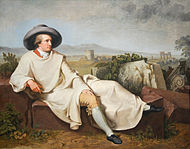 |
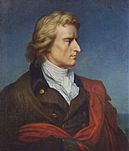 |
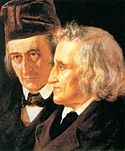 |
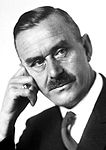 |
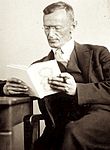 |
German loanwords in the English language
English has taken many loanwords from German, often without any change of spelling:
| German word | English loanword | Meaning of German word |
|---|---|---|
| abseilen | abseil | to descend by rope / to fastrope |
| Angst | angst | fear |
| Ansatz | ansatz | onset / entry / math. approach |
| Anschluss | anschluss | connection / access / annexation |
| Automat | automat | automation / machine |
| Bildungsroman | bildungsroman | novel concerned with the personal development or education of the protagonist |
| Blitz | Blitz | flash / lightning |
| Bratwurst | bratwurst | fried sausage |
| Delikatessen | delikatessen/delicatessen | delicate / delicious food items |
| Doppelgänger | doppelgänger | lit. "double going/living person alive", look-alike of somebody |
| Edelweiß | edelweiss | edelweiss flower |
| Fest | fest | feast / celebration |
| Gedankenexperiment | Gedankenexperiment | thought experiment |
| Geländesprung | gelandesprung | ski jumping for distance on alpine equipment |
| Gemütlichkeit | gemuetlichkeit | snug feeling, cosiness, good nature, geniality |
| Gestalt | Gestalt | form or shape / creature / scheme; refers to a concept of 'wholeness' |
| Gesundheit! | Gesundheit! (Amer.) | health / bless you! (when someone sneezes) |
| Heiligenschein | heiligenschein | meteo. "holy shine" / halo |
| Hinterland | hinterland | lit. mil. "area behind the front-line": interior / backwoods |
| kaputt | kaput | out of order, not working (from French, être capot "to have made no tricks in card games", lit. "to be hoodwinked") |
| Katzenjammer | katzenjammer | lit. "cats' lament": hangover, crapulence |
| Kindergarten | kindergarten | lit. "children's garden" - nursery or preschool |
| Kitsch | kitsch | fake art, something produced exclusively for sale |
| Kraut | kraut | herb, cabbage in some dialects |
| Leitmotiv | leitmotif | guiding theme (the verb "leiten" means "to guide, to lead") |
| plündern (v.) | to plunder | lit. "taking goods by force" (original meaning "to take away furniture" shifted in German and was borrowed by English both during the Thirty Years War) |
| Poltergeist | poltergeist | lit. "rumbling ghost" (artificial compound, not originally German) |
| Realpolitik | realpolitik | diplomacy based on practical objectives rather than ideals |
| Reich | reich | empire or realm |
| Rucksack | rucksack | backpack (Ruck→"Rücken" which means "back") |
| Sauerkraut | sauerkraut | shredded and salted cabbage fermented in its own juice |
| Schadenfreude | schadenfreude | taking pleasure in someone else's misfortune |
| Sprachraum | sprachraum | lit. "place/area/room of a language": area where a certain language is spoken |
| Über | uber | over, above |
| Übermensch | ubermensch | superhuman |
| verklemmt | verklemmt | lit. "jammed": inhibited, uptight |
| Waldsterben | waldsterben | lit. "forest dieback", dying floral environment |
| Wanderlust | wanderlust | desire, pleasure, or inclination to travel or walk |
| Weltanschauung | weltanschauung | lit. "perception of the world": ideology |
| Wunderkind | wunderkind | lit. "wonder child": child prodigy, whiz kid |
| Zeitgeist | zeitgeist | lit. "spirit of the times": the spirit of the age; the trend at that time |
| Zugzwang | Zugzwang | chess term lit. "compulsion to move" |
Organisations
The use and learning of the German language are promoted by a number of organisations.
Goethe Institut
The government-backed Goethe Institut (named after the famous German author Johann Wolfgang von Goethe) aims to enhance the knowledge of German culture and language within Europe and the rest of the world. This is done by holding exhibitions and conferences with German-related themes, and providing training and guidance in the learning and use of the German language. For example the Goethe Institut teaches the Goethe-Zertifikat German language qualification.
Deutsche Welle
The German state broadcaster Deutsche Welle is the equivalent of the British BBC World Service and provides radio and television broadcasts in German and a 30 other languages across the globe. Its German language services are tailored for German language learners by being spoken at slow speed. Deutsche Welle also provides an E-learning website to learn German.

